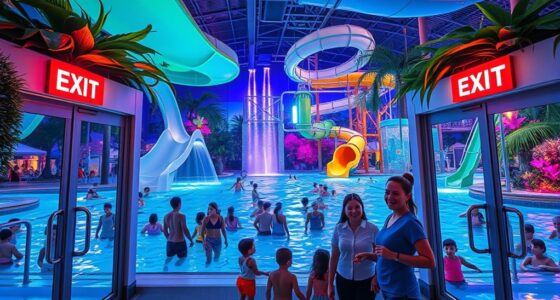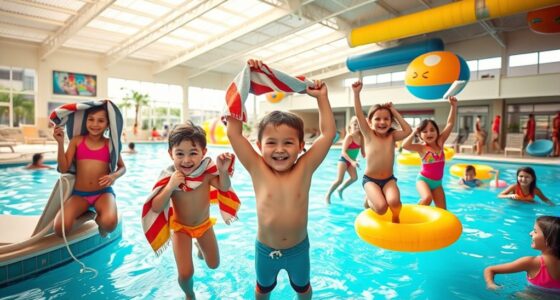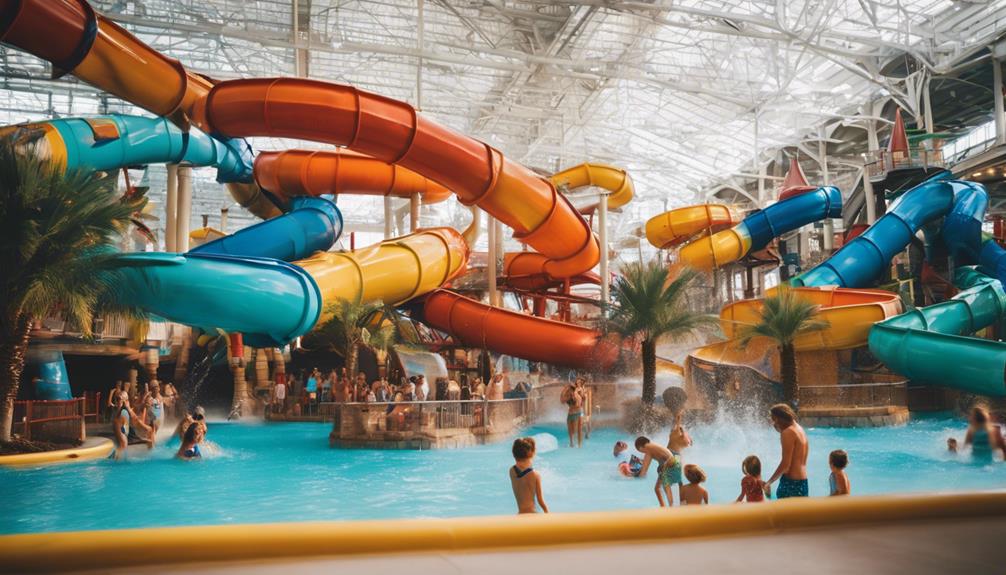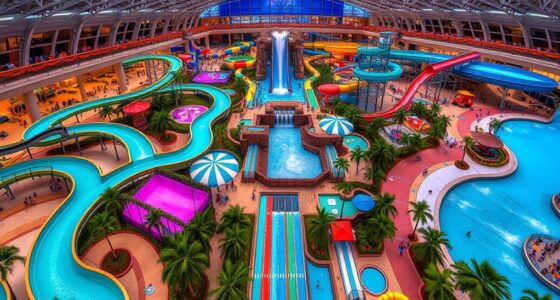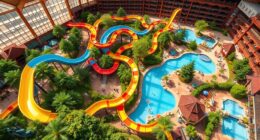Indoor splash pads are sanitized using advanced water treatment methods, like recirculating systems with chlorine or UV disinfection, which kill germs and guarantee safe water. Surfaces are cleaned weekly with non-chlorine, pH-neutral cleaners, and regularly inspected for damage. Modern disinfection technologies like hydroxyl radical generators and AI-driven robotic cleaners help maintain hygiene. Strict protocols promote user hygiene and compliance, so if you keep exploring, you’ll learn even more about keeping splash pads safe and clean.
Key Takeaways
- Indoor splash pads utilize advanced water treatment systems like recirculating filters, UV disinfection, and hydroxyl radical generators.
- Surfaces are cleaned with low-pressure washers and pH-neutral cleaners, followed by thorough rinsing to remove residues.
- Regular testing of water pH and chlorine levels ensures ongoing safety and compliance with health standards.
- AI-driven robotic cleaners and water quality monitoring optimize sanitation and surface maintenance.
- Hygiene protocols include signage, hand sanitizers, and staff supervision to promote proper user hygiene and prevent contamination.
Indoor Splash Pad Water Treatment Techniques
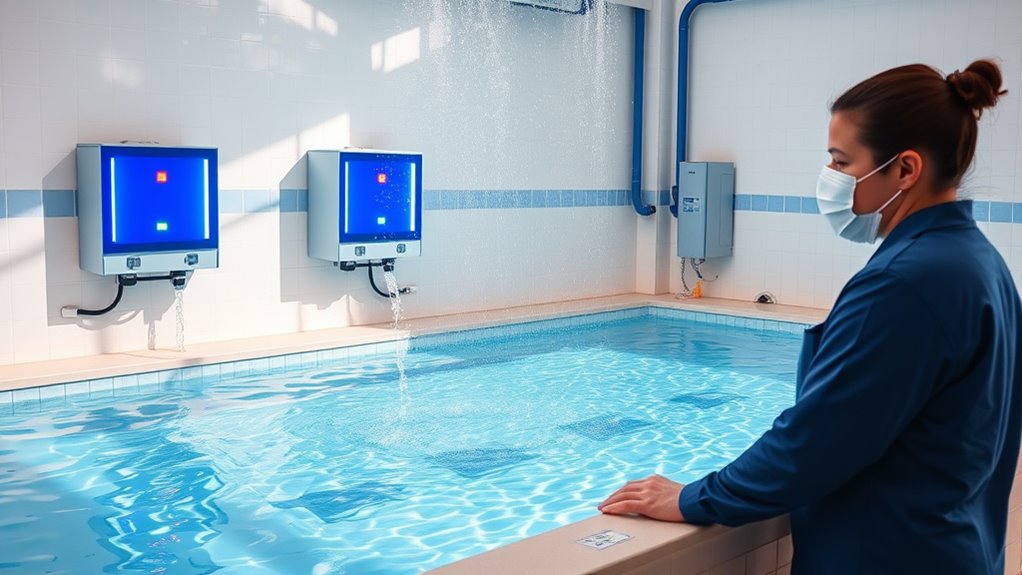
Indoor splash pad water treatment techniques rely on a combination of systems and methods to keep the water safe and clean. Recirculating systems filter and disinfect water, allowing you to reuse it and conserve resources. If your splash pad uses potable flow-through systems, water from the city supply is used once and then drained into the sewer. Chlorine disinfection is common, creating hypochlorous acid that kills bacteria and viruses, while UV disinfection provides an additional layer of safety by using ultraviolet light. Regular testing guarantees disinfectant levels stay within safe ranges, like chlorine between 1.0 and 3.0 PPM, and pH between 7.0 and 7.8. Mechanical filtration removes particles, helping maintain clarity and reducing contaminants for a safer environment. Advanced sensors monitor parameters such as pH and chlorine levels in real-time to ensure optimal water quality and quick response to any issues. Additionally, water quality monitoring systems are essential for maintaining compliance with health standards and ensuring a safe splash pad experience.
Surface Cleaning and Disinfection Protocols
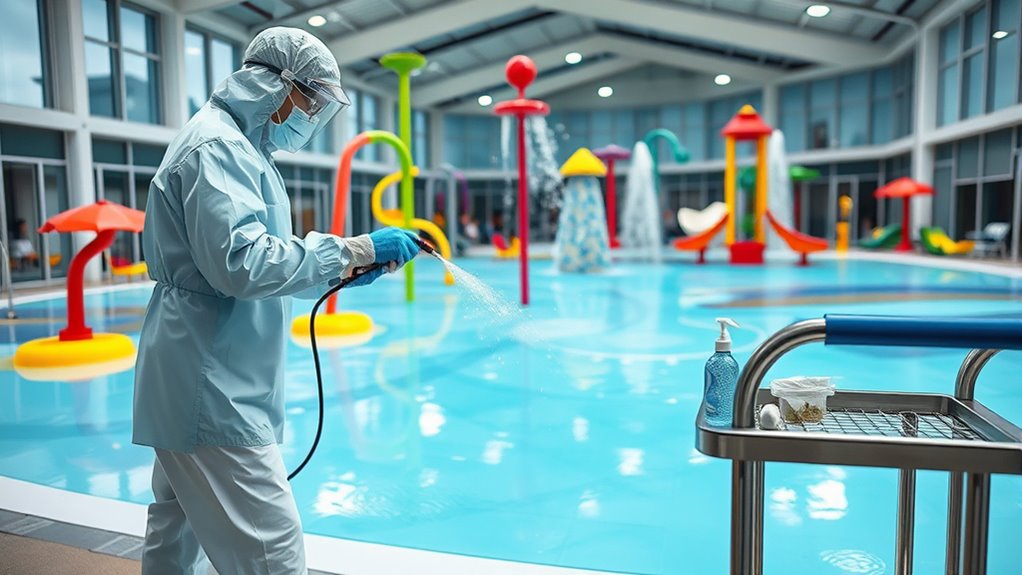
Maintaining clean and safe splash pad surfaces requires a disciplined approach to cleaning and disinfection protocols. You should use low-pressure washers under 1,500 PSI to clean surfaces effectively without causing damage. Apply non-chlorine, pH-neutral cleaners to remove grime and biofilm while preserving surface integrity. Use soft-bristle brushes to scrub dirt and maintain slip-resistant textures without harming them. Conduct weekly inspections for cracks, loose tiles, or wear, and address issues promptly to avoid further damage. Regular cleaning helps control mold, mildew, and algae growth. To prevent biological buildup, improve drainage and use specialized anti-microbial cleaners. Ensure surfaces are rinsed thoroughly after cleaning to remove residues, maintaining safe, hygienic conditions on splash pad surfaces. Proper maintenance is essential for prolonging the lifespan of the equipment and ensuring the safety of all users. Incorporating surface cleaning and disinfection protocols aligned with industry standards can further enhance safety and efficiency.
Use of Advanced Technologies for Sanitization
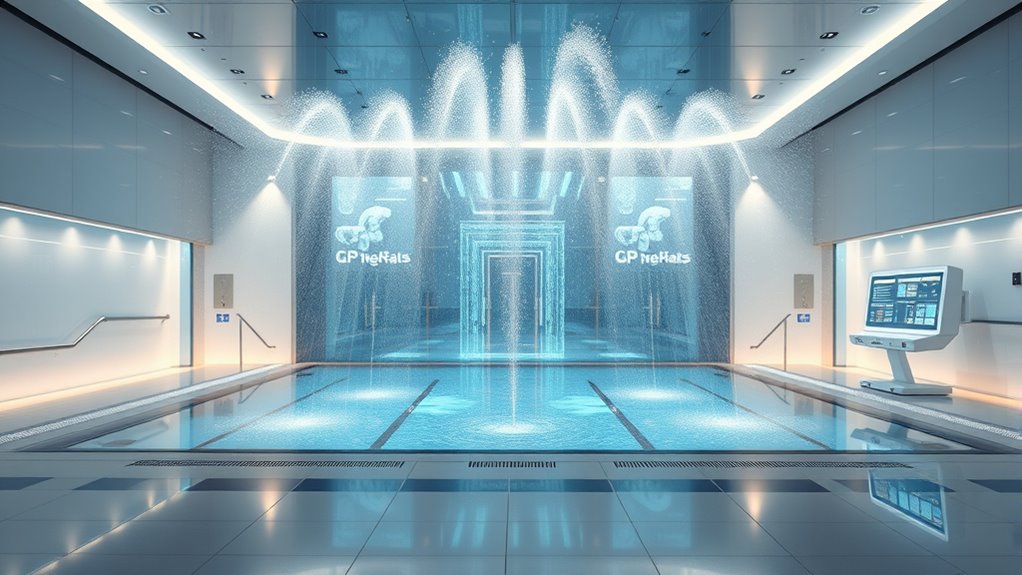
Advanced technologies like Advanced Oxidation Process (AOP) systems, UV sterilization, and AI-driven cleaning are transforming splash pad sanitation by providing more effective, efficient, and sustainable solutions. AOP systems use hydroxyl radicals to deliver powerful disinfection, reducing chemical use and disinfection by-products by up to 90%. They also eliminate 99.99% of chlorine-resistant pathogens like Cryptosporidium, with minimal maintenance—usually just cartridge replacements. Hydroxyl radicals are naturally produced in Earth’s atmosphere daily. They add an extra layer of protection by targeting bacteria, viruses, and protozoa that survive primary disinfection, especially effective against chlorine-resistant organisms. UV systems further enhance sanitation by inactivating microorganisms that are resistant to chemical disinfectants. AI-driven robotic cleaners monitor and maintain surfaces, removing debris and predicting maintenance needs with greater accuracy. These advanced technologies streamline sanitation processes, lower chemical reliance, and promote eco-friendly practices, ensuring safer, cleaner indoor splash pad environments with less effort and greater sustainability.
Maintenance Strategies for Water and Surface Safety
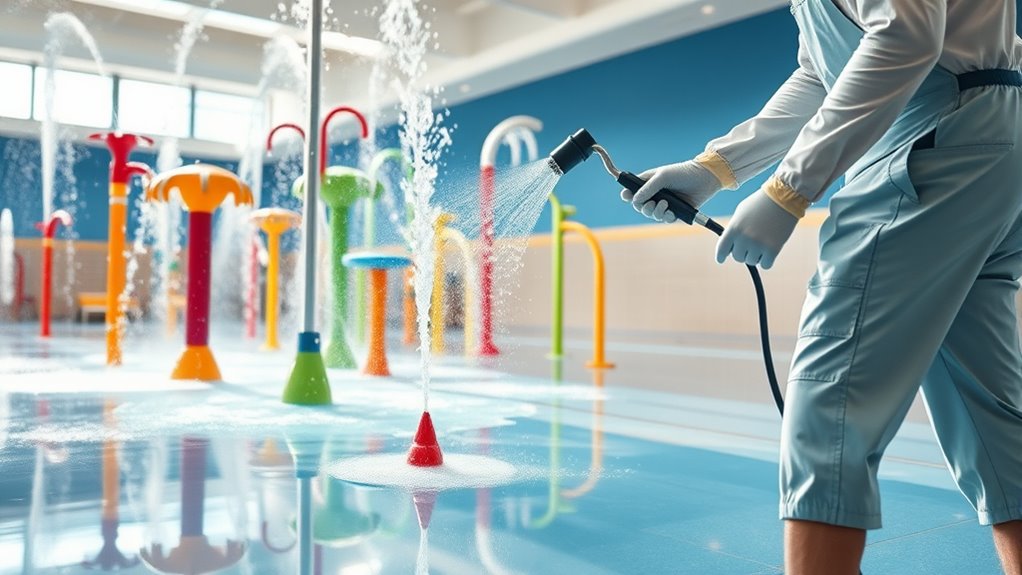
Maintaining water and surface safety in indoor splash pads requires a proactive approach to maintenance. You should regularly test water pH and chlorine levels, ensuring they stay within safe ranges. Keep water circulation systems functioning properly to prevent stagnation, and backwash filters frequently to maintain clarity and prevent bacteria buildup. Balancing chemicals is vital to avoid health risks and equipment damage. For surfaces, daily cleaning removes dirt and biofilm, while weekly inspections catch cracks or hazards. Slip resistance and debris removal reduce accidents. Regularly inspect nozzles, jets, and leaks to prevent malfunctions. Implementing real-time water monitoring systems can help detect issues immediately, ensuring continuous safety and compliance. Additionally, adhering to water safety standards and regulations ensures proper maintenance practices and safety protocols are followed. Use the following table for a clearer picture:
| Water Safety Tasks | Surface Safety Tasks |
|---|---|
| Water testing & balancing | Daily cleaning and debris removal |
| Filter backwashing | Visual inspections |
| Disinfection system upkeep | Slip resistance checks |
Promoting User Hygiene and Regulatory Compliance
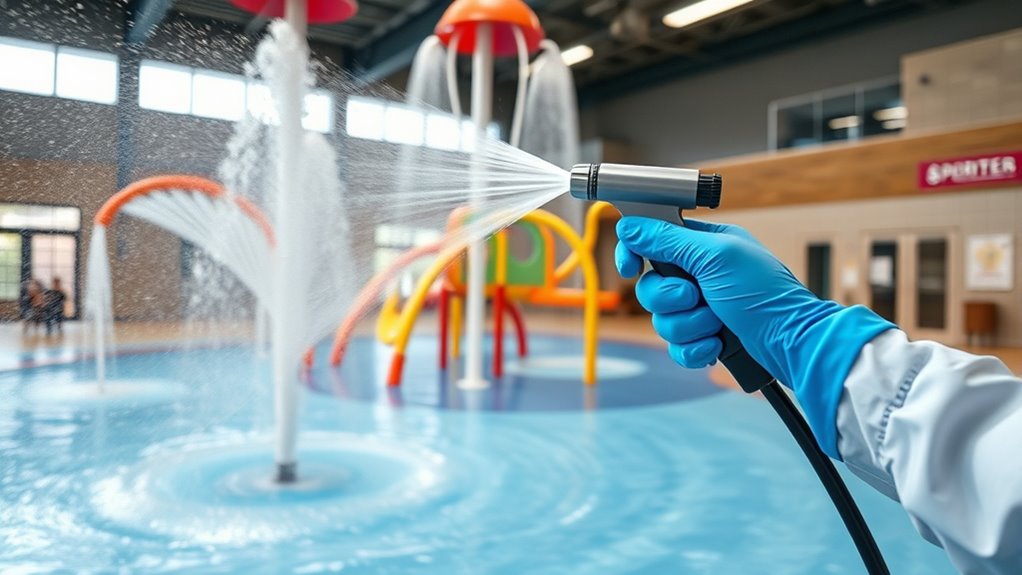
Promoting user hygiene and achieving regulatory compliance are essential steps to keep indoor splash pads safe and enjoyable. You should encourage everyone to shower or rinse off before entering to minimize germs from skin and clothing. Clear signage outlining hygiene rules—such as no urination or defecation in the water and proper diaper disposal—helps reinforce good practices. Promote the use of swim diapers, understanding they don’t fully prevent germ entry. Providing handwashing stations or hand sanitizers nearby encourages users to practice good hand hygiene before and after play. Educate staff and caretakers on enforcing these rules and supervising children. Additionally, ensure water sources meet local health standards, and the splash pad’s design prevents standing water. Regular inspections and adherence to regulations are crucial for maintaining a safe, hygienic environment. Regular cleaning and disinfection routines are vital to reduce the risk of pathogen transmission and ensure the environment remains safe for all users. Incorporating proper sanitation protocols as part of routine maintenance further supports hygiene efforts and compliance.
Frequently Asked Questions
How Often Should Indoor Splash Pad Water Be Tested for Contaminants?
You should test indoor splash pad water daily before opening and every 2-4 hours during operation. This guarantees disinfectant levels and pH stay within safe ranges, preventing germ spread and contamination. Regular testing helps you comply with health regulations, maintain water quality, and protect public health. Make sure your staff is trained, records are kept, and systems like filtration and secondary disinfection are functioning properly to ensure safety.
Are There Specific Disinfectants Recommended for Indoor Splash Pad Surfaces?
You should use EPA-registered disinfectants like Clorox or alcohol solutions with at least 70% alcohol for indoor splash pad surfaces. Diluted bleach solutions are also effective if used carefully. Before disinfecting, clean surfaces with soap and water to remove dirt and germs. Regularly check that disinfectant levels are correct and verify compatibility with materials. Proper training and adherence to safety guidelines help keep the splash pad clean and safe for everyone.
What Safety Measures Are in Place During Disinfection Procedures?
During disinfection procedures, only authorized personnel are permitted in the area, and you must wear a facemask for safety. The splash pad is closed for 30 minutes every 2 to 4 hours to ensure thorough cleaning. Access is restricted to prevent crowding, and signage clearly communicates safety rules. These measures help protect everyone’s health while maintaining a safe environment during cleaning times.
How Is Mold Prevented in Indoor Splash Pad Ventilation Systems?
You prevent mold in indoor splash pad ventilation systems by carefully controlling humidity and ensuring proper airflow. You maintain humidity levels between 50-60%, use dehumidifiers, and keep exhaust fans running to remove moist air. Regularly inspecting and maintaining your ventilation and dehumidification systems also help. By consistently monitoring humidity and ensuring proper ventilation, you create an environment where mold can’t thrive, keeping the splash pad safe and clean for everyone.
Can UV Light Be Safely Used in All Indoor Splash Pad Environments?
Yes, UV light can be safely used in indoor splash pad environments when properly installed and maintained. You need to guarantee the UV system is enclosed, shields are intact, and there’s no UV leakage. Regular maintenance like bulb replacements and cleaning is essential. When used correctly, UV disinfection effectively reduces pathogens and chloramines without exposing users to harmful UV rays, making it a safe and reliable sanitation method.
Conclusion
You can confidently enjoy indoor splash pads knowing proper sanitation keeps them safe. Regular water treatment, thorough surface cleaning, and advanced sanitization tech work together to prevent germs. Promoting good hygiene and following regulations ensure a clean, fun environment for everyone. Rest assured, these measures effectively reduce risks, making your splash pad experience both enjoyable and safe. Trust in these proven practices so you can focus on the fun without worry.



